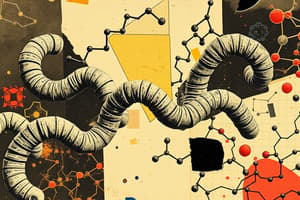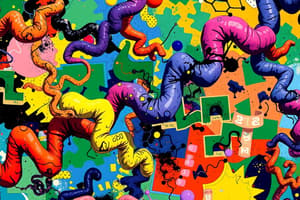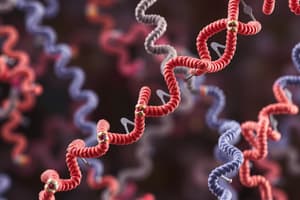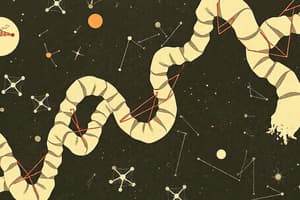Podcast
Questions and Answers
Which polymers are composed of amino acids?
Which polymers are composed of amino acids?
- Proteins (correct)
- Monomers
- Nucleic Acid
- Carbohydrates
Which of the following is not attached to the central carbon atom in an amino acid?
Which of the following is not attached to the central carbon atom in an amino acid?
- An amino functional group
- A side chain ("R group")
- An oxygen (correct)
- A carboxyl functional group
Which part of an amino acid is always acidic?
Which part of an amino acid is always acidic?
- Amino functional group
- Carboxyl functional group (correct)
- Side chain ("R group")
- None of the above
Which monomers make up RNA?
Which monomers make up RNA?
Which of the following statements about the formation of polypeptides from amino acids is true?
Which of the following statements about the formation of polypeptides from amino acids is true?
Enzymes in the digestive tract catalyze hydrolysis reactions.
Enzymes in the digestive tract catalyze hydrolysis reactions.
A dehydration reaction (or condensation reaction) is the process in which:
A dehydration reaction (or condensation reaction) is the process in which:
The four main categories of large biological molecules present in living systems are:
The four main categories of large biological molecules present in living systems are:
Glycogen is:
Glycogen is:
Glucose + Glucose = ____ by _____
Glucose + Glucose = ____ by _____
Which of these is a source of lactose?
Which of these is a source of lactose?
Which of these is a polysaccharide?
Which of these is a polysaccharide?
______ is the most abundant organic compound on Earth.
______ is the most abundant organic compound on Earth.
Which molecule is NOT a carbohydrate?
Which molecule is NOT a carbohydrate?
Which of the following statements about monosaccharide structure is true?
Which of the following statements about monosaccharide structure is true?
Peptidoglycan is a polysaccharide found only in bacteria.
Peptidoglycan is a polysaccharide found only in bacteria.
Which complex carbohydrate contains only 1,4 glycosidic linkages?
Which complex carbohydrate contains only 1,4 glycosidic linkages?
Which of the following complex carbohydrates is listed with its correct function?
Which of the following complex carbohydrates is listed with its correct function?
Which polysaccharide contains a modified monosaccharide?
Which polysaccharide contains a modified monosaccharide?
Sucrose is formed when glucose is joined to fructose by a(n):
Sucrose is formed when glucose is joined to fructose by a(n):
Plant cell walls consist mainly of:
Plant cell walls consist mainly of:
Which of these is NOT a lipid?
Which of these is NOT a lipid?
Which of these is rich in unsaturated fats?
Which of these is rich in unsaturated fats?
A function of cholesterol that does not harm health is its role:
A function of cholesterol that does not harm health is its role:
The characteristic that all lipids have in common is that:
The characteristic that all lipids have in common is that:
Palm oil and coconut oil are more like animal fats than other plant oils because they:
Palm oil and coconut oil are more like animal fats than other plant oils because they:
Which of these does NOT contain a structural protein?
Which of these does NOT contain a structural protein?
Defensive proteins are manufactured by the ____ system.
Defensive proteins are manufactured by the ____ system.
Proteins are polymers of ____.
Proteins are polymers of ____.
What type of bond joins the monomers in a protein's primary structure?
What type of bond joins the monomers in a protein's primary structure?
The secondary structure of a protein results from:
The secondary structure of a protein results from:
Tertiary structure is NOT directly dependent on:
Tertiary structure is NOT directly dependent on:
Some regions of a polypeptide may coil or fold back on themselves. This is called _____, and the coils or folds are held in place by:
Some regions of a polypeptide may coil or fold back on themselves. This is called _____, and the coils or folds are held in place by:
A hydrophobic amino acid R group (side group) would be found where in a protein?
A hydrophobic amino acid R group (side group) would be found where in a protein?
If a strand of DNA has the nitrogen base sequence 5'-ATTTGC-3', what will be the sequence of the matching strand?
If a strand of DNA has the nitrogen base sequence 5'-ATTTGC-3', what will be the sequence of the matching strand?
If a DNA double helix is 100 nucleotide pairs long and contains 25 adenine bases, how many guanine bases does it contain?
If a DNA double helix is 100 nucleotide pairs long and contains 25 adenine bases, how many guanine bases does it contain?
The two strands of a DNA double helix are held together by ______ that form between pairs of nitrogenous bases.
The two strands of a DNA double helix are held together by ______ that form between pairs of nitrogenous bases.
A nucleotide is composed of a(n):
A nucleotide is composed of a(n):
Which structure is not a component of a nucleotide?
Which structure is not a component of a nucleotide?
Which of the following statements about nucleotide structure is FALSE?
Which of the following statements about nucleotide structure is FALSE?
Guanine and Uracil are examples of nitrogenous bases.
Guanine and Uracil are examples of nitrogenous bases.
Which linkage forms the backbone of a nucleic acid?
Which linkage forms the backbone of a nucleic acid?
Which of the following statements about DNA structure is true?
Which of the following statements about DNA structure is true?
What is the complementary DNA sequence to 5' ATGCATGTCA 3'?
What is the complementary DNA sequence to 5' ATGCATGTCA 3'?
The flow of genetic information in a cell goes from:
The flow of genetic information in a cell goes from:
The building blocks or monomers of nucleic acid molecules are called:
The building blocks or monomers of nucleic acid molecules are called:
Flashcards are hidden until you start studying
Study Notes
Proteins and Amino Acids
- Proteins are polymers made from amino acids linked by peptide bonds.
- The central carbon of an amino acid is attached to an amino group, carboxyl group, side chain (R group), and hydrogen; not an oxygen.
- The carboxyl functional group (COOH) is always acidic, as it can lose a proton.
- Peptides form through condensation reactions between the carboxyl group of one amino acid and the amino group of another.
Nucleic Acids
- RNA is made up of nucleotide monomers.
- DNA and RNA are known as nucleic acids.
Carbohydrates
- The four primary categories of large biological molecules are proteins, nucleic acids, polysaccharides, and lipids.
- Glycogen is a polysaccharide found in animals, while cellulose is the most abundant organic compound on Earth and is found in plant cell walls.
Sugars and Their Linkages
- Sucrose forms from a glycosidic linkage between glucose and fructose.
- Maltose is formed from the dehydration synthesis of two glucose molecules.
- Lactose is found in milk, while cellulose is a polysaccharide consisting of structural units.
Lipids
- Lipids are characterized by their insolubility in water; they do not dissolve in water.
- Unsaturated fats are prevalent in olive oil, while palm and coconut oils contain fewer double bonds, making them more like animal fats.
Protein Structure
- Proteins consist of amino acids and can have up to four levels of structure: primary, secondary, tertiary, and quaternary.
- Secondary structure is maintained by hydrogen bonds that form in coils or folds.
- Tertiary structure involves the interaction of various side chains (R groups) and includes hydrogen and ionic bonds, but not peptide bonds.
DNA Structure and Function
- DNA's double helix is held together by hydrogen bonds between nitrogenous bases.
- Each nucleotide consists of a phosphate group, nitrogen-containing base, and a five-carbon sugar.
- DNA strands are oriented anti-parallel, with specific base pairing dictating genetic information flow from DNA to RNA to proteins.
Nucleotide Composition
- Nucleotides are the building blocks of nucleic acids, including both DNA and RNA.
- The sugar-phosphate backbone of nucleic acids is formed by phosphodiester linkages between nucleotides.
Genetic Information
- The flow of genetic information in a cell follows the sequence: DNA → RNA → Protein, establishing the foundation of molecular biology.
Additional Notes
- Enzymes in digestion catalyze hydrolysis reactions that break down food molecules.
- Defensive proteins are produced by the immune system, while structural proteins make up tissues like muscles, tendons, and ligaments.
- Peptidoglycan is a modified polysaccharide found only in bacteria.
Studying That Suits You
Use AI to generate personalized quizzes and flashcards to suit your learning preferences.





